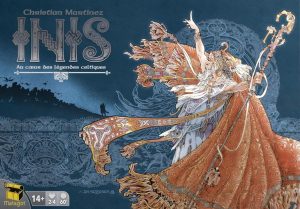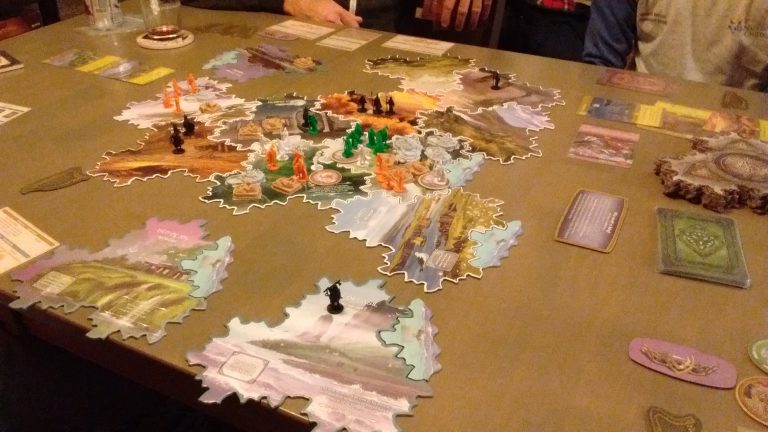Inis Review
A masterpiece of a game

By MARK WILSON

Year Published: 2016
Players: 2-4 (2-5 w/expansion)
Playing Time: 60-90 Minutes
Normally I break down a game based on established criteria. I’ll do that in a bit, but I’m breaking my review model today to tell you a story. Don’t worry, I’ve skipped to the best part…
It was the final round (as dictated by the expansion’s sudden death “We Need a King” module). We had played all of our sanctuaries, which were all over the place, but particularly concentrated in a three-tile area that included the Capital, which we knew would be a hotbed of activity. The board was gigantic, having expanded at a rate that we weren’t able to keep up, due to some aggressively explorative Epic Tale Cards. Three were left unoccupied entirely (which is absurd). Multiple paths to victory existed through these elements, for anyone able to muster the correct cards to occupy and spread to the right combination of territories. We all nervously surveyed each other, planning our route to victory and, inevitably, a backup route to victory once the first had been foiled.
Player A had ended the previous round with a Victory Condition (VC) but not the win. He only had two armies on the board, but had three Deeds and so was a threat even with so few units. Player B prevented his victory with a similar VC the previous round. Player C (me) had by far the most troops, but they were all amassed in the Capital. I had to deploy them correctly and avoid onerous conflicts, if possible. Player D was the most spread out, but was curiously absent from most of the Sanctuary tiles.
Early in the Round, Player A made his bid for two VCs, and had them briefly due to all those Deeds, but we had too many cards left to allow it to last. I benefited from Player C’s movement into the Capital, re-giving him a Sanctuary VC, but giving me the third VC (chieftain over 6+ units). I moved into a neighboring tile to try to also get Sanctuaries, but was thwarted by a truly nasty Yellow card that benefited my opponent in combat. Temporarily stymied, I began passing on my turn to allow others to deplete their cards before making my final moves, which weren’t too powerful. I was still the Brenn and had a single VC, so I’d win a lot of tiebreakers, but was at the mercy of the rest of the table due to the lost combat.
Player D had been able to retain his exploratory Epic Tale Card and used it again, increasing the unoccupied tiles to five but further expanding. Our table – normally sufficient for even expansive games – was bursting at the seams from the sheer size of our creation. The table had become the board at this point, with island tiles occupying weird corners of the table where we could squeeze them in. The size meant that it felt like we ourselves were in the play area, not just surveying it. Everyone was standing at this point, weighing their options, half in expectant calculation, half in nervousness. Player D got himself into six territories, so we all had one VC as we neared our final plays.
Running out of moves/cards, my one VC + Brenn tiebreaker was intact. Then Player D sprung one last move to give him five Sanctuaries + his lone Deed, for two total VCs and a narrow lead. I fiddled about without the right cards to counter, playing one last one that gave me an Epic Tale Card, a desperate Hail Mary in the hopes that the card would save us. The card I drew allowed me to draw four more Epic Tale Cards and distribute one to all players. Surely one of them would allow me a chance, right? I played it, sensing hope again. Player D then performed his last trick, negating it with his last Epic Tale Card.
Groans and cheers ensued, followed by mentally exhausted but contented sighs. We surveyed the board, took some pictures of the ridiculous board state we had created, and universally agreed that we had just experienced something epic and wonderful.
You guys…board games can be that.
Inis is a game that makes me wonder if people, including many longtime gamers, truly know what board games are capable of. Yes, there are elements of passive-aggressive nastiness and direct combat, so conflict-averse gamers need not apply. But it’s some of the most concentrated brilliance I’ve experienced in gaming or, indeed, in any hobby setting that promotes social interaction.
That session detailed above came after previous rounds with equally tense overtures for the win. The moments I outlined weren’t the only tense or exciting ones; they were just the last ones in a brutal but calculated dance. And while I’d call that my best session of the game, it’s far from an outlier. Every game I’ve played – a number approaching 20 at this point – has produced numerous surprising and exciting moments.

Inis – The Nuts & Bolts of Mechanical Integration
Let’s talk some details, because it isn’t just the tense moments, but the way the game masterfully constructs and supports them:
- The base mechanic, the card draft and card plays to manipulate the board state, is simplicity itself. With 17 (21 in the expansion) cards, you’ll learn all the abilities quickly, and all are eminently intuitive and printed directly on the card. However, the ways they can interact are myriad and often surprising, giving the game immediate depth.
- The tile abilities (yellow cards) naturally reward controlling areas, and while most are minor abilities, they add nuance to the proceedings depending on which you control.
- Epic Tale Cards (red) are literally the games wild cards. However, they aren’t universally powerful. What they are is specific. So they are situationally lifesaving or useless. But since you keep them round to round, you can maneuver your board presence in such a way that when you spring an Epic Tale Card at the perfect moment in the late game, it’s something you’ve been planning for multiple rounds. It’s immensely satisfying.
- The tiles are just big enough to impart a sense of grandeur, and just arcane enough to evoke a sense of mystery and wonder about the game. Plenty of games have you constructing the play area as you go along, but few feel like you’re adding so meaningfully to it each time a new tile comes into play. With the addition of a new place to claim toward victory, and a new ability to claim, bringing out a new tile is an event for everyone in play.
- The multiple paths to victory means that a rough combat or unlucky card draw doesn’t necessarily sink your chances, but merely requires adaptation. True, it reduces your chances sometimes, but look at the session above. The guy with two units on the board at round’s start had two Victory Conditions after a few well-played cards, because he had prioritized Deeds instead of physical units. Conversely, I had deliberately amassed the largest army in a less-contested tile, not knowing how exactly I’d deploy them to win as I was building it, but knowing they’d give me options in the endgame.
- There’s a mix of long-term and short term strategy here. To an untrained observer, it looks very reactionary – and it definitely often is in the endgame – but that belies the various ways you can build within the apparent chaos of the game.
- The art is wildly psychedelic, producing one of the more unique aesthetics in gaming.
- I wouldn’t call it random in any meaningful sense (Epic Tale Cards being the closest thing to an exception), but it’s often unpredictable, which creates shocking and hilarious moments of both glee and tragedy.
Perhaps the biggest compliment I can give the game is that everything in that list works together in a nearly seamless fashion to promote the experience the game is trying to deliver. Call it elegance, call it coherence, call it thematic-mechanical integration, call it whatever you want, but it’s there. Not every session will be like the one I described above. Much more often than not, though, you’ll have something profound happen at the table because there’s nothing extraneous in the game and everything combines into a larger, grander whole.
Criticisms of Inis
What are the criticisms? I want to address these, since they do exist.
Criticism the First: the game is too chaotic, swingy and arbitrary, particularly in the endgame. There’s certainly something to this, and I personally love it a bit because of that chaos. If you don’t love that, I won’t say you’re wrong, because it’s a matter of taste. However, what I would argue is that the game is designed to do this to an extent, and the actual chaos is often less pronounced than the perceived chaos. What do I mean by that? Well, in the example above, which is an excellent one for this point, we all knew someone was going to win, so we had planned our masterstrokes to unfurl in that round. The confluence of multiple masterstrokes is always going to produce the most wild swings, but each is predictable in the sense that you know what everyone is going for because the game is so bounded. True, you can’t account for every Epic Tale Card, but you can account for the types of actions you know each player needs to take in order to win.
Criticism the Second: The game is too brutal. I’ll concede that I’ve seen games where someone is on the receiving end of several bad beats and struggles to stay relevant in the game. The defense is that the game’s abilities allow for reactive pivots more than most games of its type, and that climbing back into relevance is rarely – if ever – impossible. You’re never more than a couple rounds away from grabbing a VC, and often closer. To the newer player, this can be harder because they don’t know, for example, that stockpiling Deeds can be as powerful (or moreso) than stockpiling units on the map, or that their lone unit on a tile with three Sanctuaries is sneakily useful as they build elsewhere and should likely inform what cards they draft. This is what will turn off new gamers, though, even if they like the genre, so it’s a valid consideration. To mitigate this, I try to prepare new players to take some lumps as they learn the in’s and out’s of the game. Knowing this is part of the learning process can help to soften the blow the game delivers. The expansion (discussed more below) also adds in a module that mitigates this somewhat, one that provides a few rewards designed to usher the most harried or put-upon player(s) back to competitive relevance.
Criticism the Third: the game could be over in 30 minutes or two and a half hours, which makes it hard to recommend. This is partially true of the base game. Frankly, most games will last 60-90 minutes, though outliers do exist. I personally don’t mind those outliers, but will also admit that, yes, it’s a harder sell when you can’t tell someone how long their commitment to playing will last. To that end, though, if this is a concern in your group, you should check out the excellent expansion, Seasons of Inis, which addresses this directly. With the expansion’s length-mitigating module, I’ve never seen the game go past the 5th round, and that includes sprawling epics like the one described above.
Criticism the Fourth: the game promotes kingmaking and bashing the leader. Yes, it does. Or rather, actual kingmaking is very rare, but the late game is a constant struggle to pull would-be winners back to the pack, often by teaming up against them. Look, terms like “bash the leader” are usually used pejoratively. If you don’t like it in games, this game isn’t for you. But if you enjoy rolling in the mud with 1-4 other players, clawing at each others eyeballs and punching below the belt to gain every advantage, it’s a glorious mud bath.
Criticisms Conclusion
I think each of those criticisms overlap somewhat, in that they speak to a certain player type that isn’t going to enjoy this game. My rebuttals aren’t likely to sway you if this simply isn’t your style of game, and that’s fine.
Nature of the Hybrid Game
To be clear, there’s combat here, but I wouldn’t call it the focus of the game. Unlike some that have combat but lean more toward Euro elements (you can win Scythe without ever fighting, for example), you’ll never play a game of Inis without combat, but it doesn’t need to be the hallmark of your strategy.
If you want that sort of brutality, Kemet will be your jam. Inis is subtler, because it’s often the sly non-combat movement or clever expansionary policy that wins out over overt aggression. The game as a whole rewards cleverness, not brute force. You’ll have to be a jerk at some point to win, but you’ll often feel like an assassin that does their business and fades into the crowd, as opposed to a warlord shaking your fists in victory over the husks of your enemies. If you go for the latter in Inis, more often than not you’ll win the battle but not the war, as you’ll have depleted your resources and units too much to claim final victory.
Hybrid games are all the rage, and this definitely blends a Euro-style card draft – and even some Euro concepts in its combat structure – with the distinct feel of a “troops on a map” game. Because of how those elements combine, as detailed above, I think it’s one of the most tightly constructed games of its type, and the best part is that the other players at the table are an intimate part of the game’s challenge.
Expansion: Seasons of Inis
I did a review of the expansion, which I think is worth checking out. The tl;dr version is that it’s a great addition if your group will benefit from a fifth player, or if you play Inis enough that you want some new options to refresh the experience. For those who only play occasionally, though, or who are checking the game out for the first time, I’d say the base game is plenty. The session I described above was with the expansion, but the base game is fully capable of delivering those types of moments on its own.
Inis – Conclusions
I love strategy and tactics, but I tend to become bored with the most insular puzzles where I’m buried in my own little world, with minimal interaction to boost my flagging interest.
Similarly, I have a hard time truly loving many “troops on a map” games, perhaps because they lack the complete integration of Inis in terms of how their mechanics compliment the experience. Inis’s highs are incomparably higher for me than the best most games can provide, and its lows are mitigated by the fact that I know I’m never far from grinding back to an epic moment.
I’ve described the game to some as Concordia + Cosmic Encounter, which might be inexact, but captures my love for this game. It combines the elegance, simplicity and strategic depth of the former with the kinetic player interaction, unpredictable moments and crushing (or glorious) moments of the latter, and it’s all wrapped into a single experience.
Even where it currently sits on Board Game Geek, just outside the site’s top 100 games of all-time, I can’t help but feel this one is a touch underrated. But I also understand that, because it’s a polarizing game. I’m a big fan of polarizing games in general, even if I dislike a particular one, because chances are it’s someone’s favorite game. But it will also be among another gamer’s least favorite. It’s often better to do that than to make a game that will be generally liked by more people, but truly loved by fewer.
And for me, at the time of writing this, it’s my favorite game, period, and given my love for board gaming as a whole, I’m frequently and genuinely shocked by just how far ahead of any other game it sits on that list.
…
For more content, or just to chat, find me on Twitter @BTDungeons, and if you enjoy my work, be sure to subscribe on Youtube!
Share
Recent Posts
Categories
- All (350)
- Announcements (4)
- Board Games (203)
- DMing (28)
- Game Design (16)
- Playing TTRPGs (22)
- Reviews (189)
- RPGs (142)
- Session Reports (91)
- Why Games Matter (9)